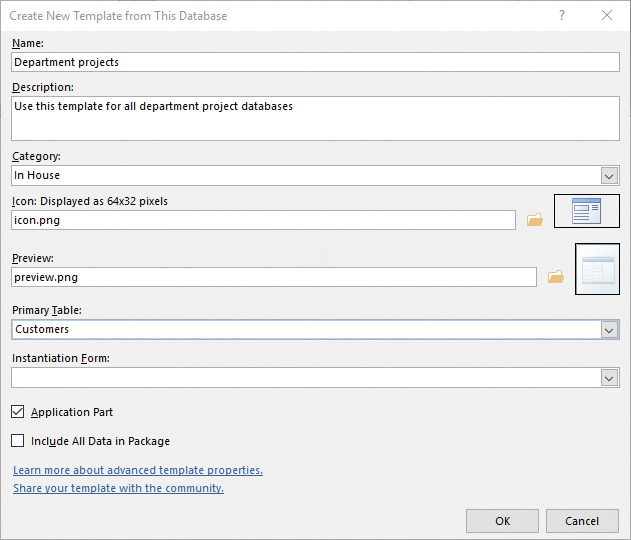Objective 1.5 Print and export data
- 1.5.1 Print reports and records
- 1.5.2 Save a database as a template
- 1.5.3 Export data
OBJECTIVE 1.5: CONTENTS
1.5.2 Save a database as a template
As described earlier in this chapter, you can use a template as the basis for a new database. The template can provide a set of default database objects (tables, forms, and reports, for example) that you customize for the needs of a specific database.
You can also save a database that you create (either from scratch or by using a template) as a template. You might use this option to save a basic contact database that includes information you need in more than one database. You might also create a set of forms with a look and feel that you want each database to include and then save those forms as a template. By default, templates are stored in your user profile, in \AppData\Roaming\Microsoft\Templates\Access.
In the Create New Template From This Database dialog box, you can categorize the templates you create. Access sets the Category box to User Templates by default, but you can define a category of your own and assign a template to it. If you plan to share this template with other users or just want to add a professional touch to a template you’re creating for yourself, you can specify an image file to use as an icon for the template. This icon replaces the standard Access icon in the program’s application window and as the thumbnail preview of the template that appears in the Backstage view. You can also specify a preview image and a form that appears when the database opens. If the database you are saving as a template already includes data, you can include that data in the template or include only the database objects themselves, without any data.
The Instantiation Form list specifies the form you want to display as a splash screen, for example. Access displays the form you select in this list only once and then deletes the form. Be careful not to confuse this option with a startup form, which you can specify for the current database by using the Access Options dialog box.
You can include the template as an application part, which makes it available in the Application Parts gallery on the Create tab. The application part appears under the heading you provide in the Category box in the Create New Template From This Database dialog box. The template is also available on the Access startup screen or on the New page in the Backstage view.
To save a database as a template
1. Create and format the database objects you want to include in the template. Enter any data you want the template to store by default.
2. Click the File tab, and then click Save As. In the Database File Types list, click Template, and then click Save As.
3. In the Create New Template from This Database dialog box, enter a name and description for the database, and then specify a category, icon image, preview image, and instantiation form (if you want to use one).
4. Select the Application Part check box to add this template to the Application Parts gallery, and then specify a primary table for the template.
5. Select Include All Data in Package as applicable.
